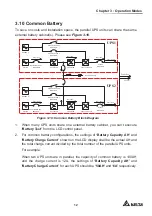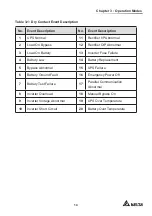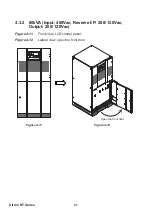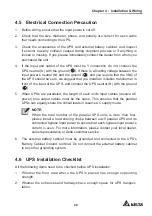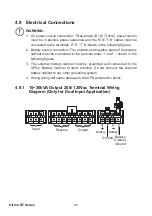
Chapter 4 Installation & Wiring
26
4.5 Electrical Connection Precaution
%HIRUHZLULQJHQVXUHWKDWWKHLQSXWSRZHULVFXWRႇ
2. Check that the size, diameter, phase, and polarity are correct for each cable
that needs connecting to the UPS.
3. Check the accessories of the UPS and external battery cabinet, and inspect
if exterior has any collision caused during shipment process or if anything is
loosen or missing. If yes, please immediately contact the dealer from whom you
purchased the unit.
4. If the input and output of the UPS must be Y connection, do not connect the
UPS neutral (N) with the ground (
,IWKHUHLVDÀRDWLQJYROWDJHEHWZHHQWKH
input power’s neutral (N) and the ground ( ) and you require that the VNG of
the UPS should be zero, we suggest that you install an isolation transformer in
front of the input of the UPS, and connect the UPS neutral (N) with the ground
( ).
5. When UPSs are paralleled, the length of each unit's input cables (reserve AC
power) plus output cables must be the same. This ensures that the parallel
UPSs can equally share the critical loads in reserve AC supply mode.
NOTE:
When the total number of the parallel UPS units is more than four,
please install a load sharing choke between each parallel UPS and its
connected bypass input power to ensure that each bypass input power’s
current is even. For more information, please contact your local dealer,
sales representative or Delta customer service.
6. The external battery cabinet must be grounded and connected to the UPS’s
‘Battery Cabinet Ground’ terminal. Do not connect the external battery cabinet
to any other grounding system.
4.6 UPS Installation Checklist
All the following items need to be checked before UPS installation:
1. Whether the floor area where the UPS is placed has enough supporting
strength.
2. Whether the entrances and hallways have enough space for UPS transpor-
tation.

